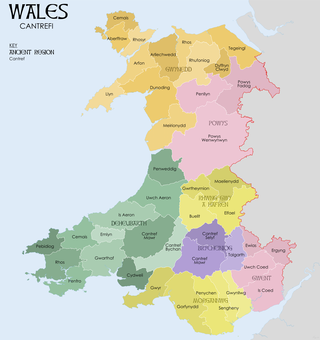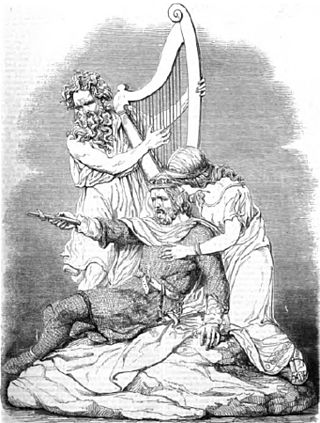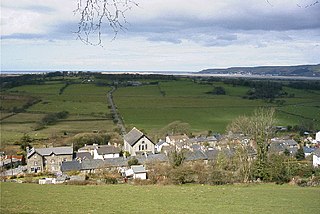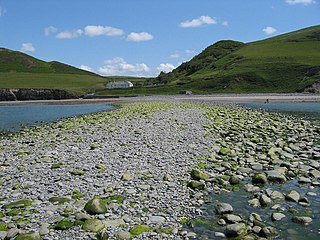Lyonesse is a kingdom which, according to legend, consisted of a long strand of land stretching from Land's End at the southwestern tip of Cornwall, England, to what is now the Isles of Scilly in the Celtic Sea portion of the Atlantic Ocean. It was considered lost after being swallowed by the ocean in a single night. The people of Lyonesse were said to live in fair towns, with over 140 churches, and work in fertile, low-lying plains. Lyonesse's most significant attraction was a castle-like cathedral that was presumably built on top of what is now the Seven Stones Reef between Land's End and the Isles of Scilly, some 18 miles (29 km) west of Land's End and 8 miles (13 km) north-east of the Isles of Scilly. It is sometimes spelled Lionesse.

Gwyn ap Nudd is a Welsh mythological figure, the king of the Tylwyth Teg or "fair folk" and ruler of the Welsh Otherworld, Annwn, and whose name means “Gwyn, son of Nudd”. Described later on as a great warrior with a "blackened face", Gwyn is intimately associated with the otherworld in medieval Welsh literature, and is associated with the international tradition of the Wild Hunt.
In Welsh mythology, Elffin ap Gwyddno was a son of Gwyddno Garanhir, 'Lord of Ceredigion'. The earliest example of the name occurs in several of the mythological poems attributed to Taliesin in the Book of Taliesin. The date of their composition is uncertain but probably predates the Norman conquest. Several late medieval compositions refer to Elffin and Taliesin in more detail.

Maelgwn Gwynedd was King of Gwynedd during the early 6th century. Surviving records suggest he held a pre-eminent position among the Brythonic kings in Wales and their allies in the "Old North" along the Scottish coast. Maelgwn was a generous supporter of Christianity, funding the foundation of churches throughout Wales and even far beyond the bounds of his own kingdom. Nonetheless, his principal legacy today is the scathing account of his behavior recorded in De Excidio et Conquestu Britanniae by Gildas, who considered Maelgwn a usurper and reprobate. The son of Cadwallon Lawhir ap Einion and great-grandson of Cunedda, Maelgwn was buried on Ynys Seiriol, off the eastern tip of Anglesey, having died of the "yellow plague"; quite probably the arrival of Plague of Justinian in Britain.

Taliesin was an early Brittonic poet of Sub-Roman Britain whose work has possibly survived in a Middle Welsh manuscript, the Book of Taliesin. Taliesin was a renowned bard who is believed to have sung at the courts of at least three kings.

Edward Williams, better known by his bardic name Iolo Morganwg, was a Welsh antiquarian, poet and collector. He was seen as an expert collector of Medieval Welsh literature, but it emerged after his death that he had forged several manuscripts, notably some of the Third Series of Welsh Triads. Even so, he had a lasting impact on Welsh culture, notably in founding the secret society known as the Gorsedd, through which Iolo Morganwg successfully co-opted the 18th-century Eisteddfod revival. The philosophy he spread in his forgeries has had an enormous impact upon neo-Druidism. His bardic name is Welsh for "Iolo of Glamorgan".
Rhun ap Maelgwn Gwynedd, also known as Rhun Hir ap Maelgwn Gwynedd, sometimes spelt as 'Rhûn', was King of Gwynedd. He came to the throne on the death of his father, King Maelgwn Gwynedd. There are no historical records of his reign in this early age. A story preserved in both the Venedotian Code and an elegy by Taliesin says that he waged a war against Rhydderch Hael of Alt Clut and the kings of Gododdin or Manaw Gododdin. The small scattered settlement of Caerhun in the Conwy valley is said to be named for him, though without strong authority. Rhun also appears in several medieval literary stories, as well as in the Welsh Triads. His wife was Perwyr ferch Rhûn "Ryfeddfawr" and their son was Beli ap Rhun "Hîr".
Medieval Welsh literature is the literature written in the Welsh language during the Middle Ages. This includes material starting from the 5th century AD, when Welsh was in the process of becoming distinct from Common Brittonic, and continuing to the works of the 16th century.

Urien ap Cynfarch Oer or Urien Rheged was a sixth-century ruler of the territory known as Rheged. His existence is confirmed by a ninth-century history and eight praise-poems to him possibly to be dated to his lifetime, attributed to the poet Taliesin. Urien features in medieval literature from Wales as one of the most celebrated figures of Welsh legend down to today. Outside of the Welsh context, he eventually was transformed in Arthurian legend into the figure of king Urien of Garlot or Gore. His most celebrated son, Owain mab Urien, similarly gave his name to the character of Ywain.

A cantref was a medieval Welsh land division, particularly important in the administration of Welsh law.
The Battle of Arfderydd was fought in medieval Britain in AD 573, according to the Annales Cambriae. The opposing armies are identified in a number of Old Welsh sources but vary between them, perhaps suggesting several allied armies were involved. The main adversaries appear to have been Gwenddoleu ap Ceidio and either the princely brothers Peredur and Gwrgi or King Rhydderch Hael of Strathclyde. Gwenddoleu was defeated and killed in the battle. His bard, Myrddin Wyllt, reportedly went mad and ran into the forest. He is one of several proposed origins for the Arthurian character Merlin. The Welsh Triads refer to this battle as one of the "Three Futile Battles of the Island of Britain", along with the Battle of Camlann and the Battle of the Trees.

Bedd Taliesin is the legendary grave (bedd) of the poet Taliesin, located in Ceredigion, Wales. The Bronze Age round cairn is a listed Historic Monument. It is a round-kerb cairn with a cist about 2m long. The capstone has fallen; the side stone slabs are more or less in their original positions.

Tewdrig ap Teithfallt, known simply as Tewdrig, was a king of the post-Roman Kingdom of Glywysing. He abdicated in favour of his son Meurig (Maurice) and retired to live a hermitical life, but was recalled to lead his son's army against an intruding Saxon force. He won the battle, but was mortally wounded.

Cantre'r Gwaelod, also known as Cantref Gwaelod or Cantref y Gwaelod, is a legendary ancient sunken kingdom said to have occupied a tract of fertile land lying between Ramsey Island and Bardsey Island in what is now Cardigan Bay to the west of Wales. It has been described as a "Welsh Atlantis" and has featured in folklore, literature, and song.
Seithenyn sometimes known as Seithenyn of the feeble mind is a figure from Welsh legend, apparently contemporary with King Gwyddno Garanhir. He is mentioned in a poem in the Llyfr Du Caerfyrddin, but becomes the protagonist of the story in a later version of the legend, in which he was responsible for the sea-defences of Cantre'r Gwaelod or Maes Gwyddno, in the kingdom of the legendary Gwyddno Garanhir, but neglected them one night because of his drunkenness. Because of this neglect, the sea overran it.
Helig ap Glanawg is a legendary figure described in various accounts dating to at least as early as the 13th century as a 6th-century prince who lived in North Wales.
Llys Helig is the name of a natural rock formation off the coast at Penmaenmawr, north Wales. There may be a fish weir to the south which tradition dates to the beginning of the 6th century. The sea level was low enough around 1600 AD to make the claims of Sir John Wynne of Gwydir feasible. The earliest known use of the name Llys Helig for this rock formation is the Halliwell Manuscript which is believed to date to around the beginning of the 17th century, eleven centuries later. Legends developed about it suggesting that it was the palace of Prince Helig ap Glanawg who lived in the 6th century, and whose sons established a number of churches in the area. He owned a large area of land between the Great Orme's Head near Llandudno and the Menai Strait off the north coast of Gwynedd.

Tre-Taliesin is a village in Ceredigion, Wales, on the A487 road, 9 miles north of Aberystwyth and 9 miles south of Machynlleth. It is in the parish of Llangynfelyn.

Sarn Gynfelyn is a shingle spit on the coast of Cardigan Bay, in the county of Ceredigion, Mid-Wales, in the United Kingdom. It is located at Wallog, a few kilometres north of Llangorwen, close to Clarach Bay, south of Borth and north of the town of Aberystwyth. It extends, albeit with a single break, for a distance of 11km from the coast to a reef known as Patches or Caerwyddno.










